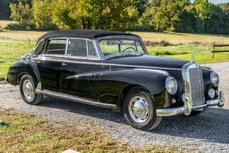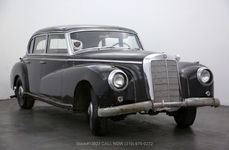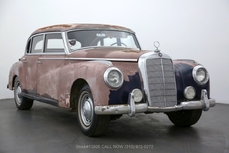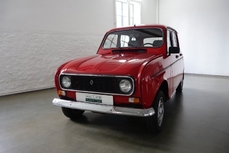Mercedes-Benz 300 W186 Adenauer , 300 Adenauer Cabriolet D 1953
General description :
Die Baureihe Mercedes-Benz W 186 der Marke Mercedes-Benz ist allgemein unter der Verkaufsbezeichnung Mercedes-Benz 300 bekannt. Die Daimler-Benz AG stellte ihren neuen Pkw der Oberklasse mit Sechszylinder-Reihenmotor im April 1951 auf der 34. Internationalen Automobil-Ausstellung in Frankfurt am Main vor. Der davon abgeleitete zweitürige Mercedes-Benz 300 S (W 188) folgte im Oktober 1951 auf der Mondial de l’Automobile in Paris. Der Typ W 186 wurde 1957 durch den verbesserten W 189 mit weitgehend gleicher Karosserie ersetzt.
Der Mercedes-Benz 300 war neben dem kleineren Mercedes-Benz 220 (W 187) die erste deutsche Repräsentationslimousine nach dem Zweiten Weltkrieg. Der anfangs 115 PS starke Mercedes 300 war zusammen mit dem 35 PS stärkeren 300 S und dem Porsche 356 1500 S (70 PS) das schnellste Serienfahrzeug deutscher Produktion. Nachdem sich der erste deutsche Bundeskanzler Konrad Adenauer für dieses Fahrzeug als Dienstwagen entschieden hatte, bürgerte sich die Bezeichnung „Adenauer-Mercedes“ für den W 186-300er ein. Neben diesem gab es noch andere 300er-Mercedes wie den W 188 oder den bekannten 300 SL „Flügeltürer“ (W 198).
Eine technische Besonderheit der gesamten Baureihe 300 war die Zentralschmierung, durch die damals noch übliche Schmiernippel überflüssig wurden. Was sonst einen Werkstattbesuch erforderte, konnte nun vom Fahrer ohne anzuhalten durch Tritt auf einen Stempel links oben neben der Pedalerie erledigt werden. Eine weiße Kontrollleuchte, die alle 100 km aufleuchtete, erinnerte den Fahrer daran, diesen für die Betriebssicherheit notwendigen Vorgang regelmäßig durchzuführen.
Bis zur Einführung des Mercedes-Benz 600 (W 100) im Jahr 1964 war der W 186 bzw. sein Nachfolger W 189 „die“ deutsche Staatslimousine schlechthin. Auch viele Staatsoberhäupter anderer Länder nutzten ihn.
Dieses schöne 300er Cabriolet stammt aus dem Jahre 1953 und war bei einem deutschen Sammler, der das Fahrzeug umfangreich überarbeiten ließ. Die Lackierung wurde erneuert, dabei war die Karosserie zerlegt.
Bei dem heutigen Besitzer wurde noch mal die Technik aufwendig instandgestzt. Ein Mercedes Spezialist kümmerte sich sehr sorgfältig um diesen schönen Mercedes und es wurde noch mal viel investiert.
Das Fahrzeug ist matching Numbers und umfangreich dokumentiert
Erstauslieferung Bankhaus Oppenheim Köln !
EZ 1.7.1953
TÜV 7.2018
Laufleistung nach Restauration ca. 9000 KM
H - Kennzeichen
Sehr schöne Farbkombination Tabakbraun mit Leder Beige
Im Kundenauftrag
Besichtigung gern nach Terminvereinbarung
Die Fahrzeugbeschreibung ist unverbindlich, dient nur der allgemeinen Identifizierung des Fahrzeuges und stellt keine zugesicherten Eigenschaften, einen Anspruch darauf oder eine Gewährleistung im kaufrechtlichen Sinne dar. Irrtümer, Eingabefehler und Zwischenverkauf vorbehalten.
1953 Mercedes-Benz 300 W186 Adenauer , 300 Adenauer Cabriolet D is listed for sale on ClassicDigest in Gut StellmoorDE-22926 Ahrensburg by Hallier Classic Cars GmbH for €179900.
Car Facts
Car type : Car Make : Mercedes-Benz Model : 300 W186 Adenauer Model Version : , 300 Adenauer Cabriolet D Engine size : 3.0 Model Year : 1953 Sub type : Convertible Location : Gut StellmoorDE-22926 Ahrensburg Vehicle Registration : Undefined
179900 €
Seller Information
Hallier Classic Cars GmbH
Hallier Classic Cars GmbH
+49 (0)4102 779958683
Hallier Classic Cars GmbH
+49 (0)4102 779958683
People who viewed this Mercedes-Benz 300 W186 Adenauer also viewed similar Mercedes-Benz listed at ClassicDigest
Other cars listed for sale by this dealer
About Mercedes-Benz
In the annals of automotive history, the journey of Mercedes-Benz is a tale that unfolds with the ingenuity of its founding pioneers. In the year 1886, Karl Benz crafted the Benz Patent Motorwagen, a creation that would go down in history as the world's inaugural automobile. Unbeknownst to him, this moment marked the genesis of what would evolve into the most illustrious premium car manufacturer globally. The financial underpinning of this pioneering venture, interestingly, was provided by Karl Benz's wife, Bertha Benz, demonstrating a remarkable partnership that would set the tone for Mercedes-Benz's legacy.A parallel narrative emerged not far away, as Daimler-Motoren-Gesellschaft, founded by Gottlieb Daimler and Wilhelm Maybach, entered the scene. In 1901, they unveiled their automobile under the now-famous moniker "Mercedes," meaning "godsend" in Spanish. This name was bestowed upon the car at the behest of Emil Jellinek's daughter, the distributor for Daimler-Motoren-Gesellschaft. The wheels of innovation were set in motion.
Fast forward to 1926, a pivotal year that witnessed the merger of Daimler with Benz & Cie., culminating in the birth of Daimler-Benz. The amalgamation saw the adoption of "Mercedes-Benz" as the distinguished trademark for their automobiles, fusing the legacies of two visionary entities into one.
Contrary to perceptions of conservatism, the trajectory of Daimler-Benz unfolds as a chronicle of industry firsts. From the introduction of the honeycomb radiator to the float carburetor, and the pioneering implementation of four-wheel brakes in 1924, Daimler-Benz consistently pushed the boundaries of automotive innovation. The diesel-powered Mercedes-Benz 260 D in 1936 marked the inception of diesel engines in passenger cars. The iconic Mercedes-Benz 300SL Gullwing made history as the first car with direct fuel injection, albeit the Gutbrod's tiny 2-stroke engine can claim precedence.
Safety innovations became a hallmark, with Béla Barényi's patented safety cell design in the "Ponton"-models in 1951, featuring front and rear crumple zones. The W116 450SEL 6.9 saw the introduction of the Anti-Lock Brake system (ABS), another pioneering safety feature. From the first production airbags and beyond, the legacy of "firsts" continued to be etched into the fabric of Daimler-Benz.
Over its centennial journey, Mercedes-Benz has not merely produced cars but has sculpted automotive icons. The SSKL, 710 SSK Trossi Roadster, 770K Grosser, 540K Spezial Roadster, 300SL Gullwing, w100 600 Pullman, w111 280SE 3.5 Flachkühler, w113 230SL Pagoda, w109 300 SEL 6.3, and w201 2.3-16 Cosworth stand testament to the brand's commitment to engineering excellence.
The roaring Silver Arrows, or "Silberpfeile," including the W 25, W 125, W154, W165, and W196, created a legacy of dominance on the racetrack. These machines were not merely cars; they were expressions of precision, speed, and an indomitable spirit that left their competitors in the dust.
As Mercedes-Benz marches into the future, it does so not just as an automaker but as a custodian of a legacy, a torchbearer of innovation, and a beacon of automotive excellence. The road ahead is sure to witness the continued fusion of cutting-edge technology, timeless design, and an unwavering commitment to setting new standards in the world of automobiles.
One luminary figure who left an indelible mark was Béla Barényi, often heralded as the "father of passive safety" for his pioneering work in safety engineering. His patented safety cell design, featuring front and rear crumple zones, became a hallmark of Mercedes-Benz's commitment to occupant safety, setting new standards that reverberated throughout the automotive world.
Moving through the chronicles, the collaborative genius of Wilhelm Maybach, alongside Gottlieb Daimler, laid the foundation for Daimler-Motoren-Gesellschaft. Their innovations not only birthed the first Mercedes but established a culture of relentless pursuit of technological excellence that remains integral to Mercedes-Benz's DNA.
In the post-merger era of 1926, Ferdinand Porsche emerged as a prominent figure within Mercedes-Benz. His work on the Mercedes-Benz S-Type, a supercharged race car, garnered acclaim and set the stage for a legacy that extended far beyond the marque. Porsche's impact would later extend to his eponymous company, but his influence at Mercedes-Benz during those formative years was pivotal.
As the 20th century progressed, the legendary Rudolf Uhlenhaut emerged as a key figure. Uhlenhaut, an accomplished engineer and the driving force behind the iconic Silver Arrows, played a crucial role in Mercedes-Benz's dominance in motorsports. His engineering prowess and attention to detail were instrumental in creating some of the most formidable racing cars of the era.
In the latter half of the century, figures like Bruno Sacco, the head of design at Mercedes-Benz from 1975 to 1999, left an indelible imprint on the brand's aesthetic identity. Sacco's design philosophy, characterized by clean lines and timeless elegance, shaped iconic models like the W126 S-Class and the W201 190E, solidifying Mercedes-Benz's reputation for luxury and sophistication.
The narrative would be incomplete without acknowledging the contributions of engineers like Hans Scherenberg, whose leadership in the 1970s ushered in a new era of technological innovation at Mercedes-Benz. Scherenberg's tenure saw the development of groundbreaking technologies, including the Anti-Lock Brake system (ABS) and the introduction of airbags in production cars.

























